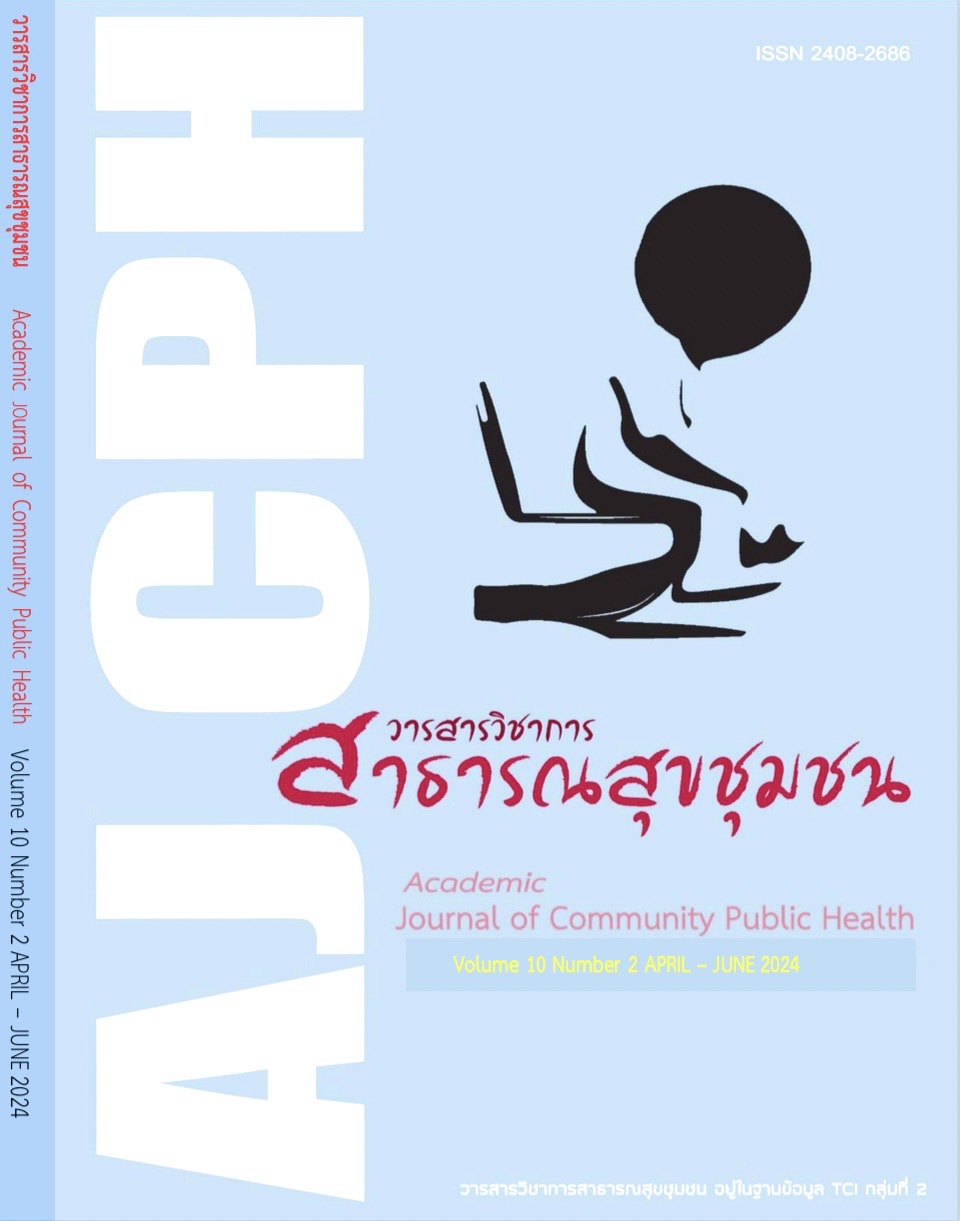A Comparison Efficacy of Telemedicine Platform and Traditional Algorithm in Patient with Diabetes Mellitus for Control Blood Sugar in Mahachanachai Hospital Yasotorn Hospital
Keywords:
Telemedicine, Traditional Algorithm, Diabetes Mellitus, Control Blood SugarAbstract
The research aimed to compare the effectiveness of telemedicine examination with conventional examination by doctors in diabetic patients for controlling blood sugar levels. The study followed a Quasi-Experimental Research design under the concept of Diabetes Self-Management Education and Support (DSMES). The study population consisted of type 2 diabetes patients who were unable to maintain blood sugar levels (HbA1c ≥ 7). These patients were divided into two groups: Group 1 (Experimental group): 39 patients underwent telemedicine examination using LINE Application for video calls. Group 2 (Control group): 39 patients received conventional examination by doctors at Mahachanachai Hospital Yasotorn Hospital. The study lasted for 12 weeks and data were analyzed using descriptive and inferential statistical. Result: HbA1c Levels: After 12 weeks of follow-up, the mean HbA1c levels decreased from the initial values in both groups. However, no statistically significant difference was observed between the telemedicine group and the conventional examination group (p = 0.328). Fasting Plasma Glucose (FPG): There was no significant difference in FPG levels between the two groups (p = 0.127). PAM13 Scores: The telemedicine examination group showed a statistically significant increase in mean PAM13 scores (p = 0.002). Summary: Telemedicine examination is a safe option for low-risk diabetic patients. It helps reduce overcrowding at the Outpatient Department. Patients are satisfied because it eliminates the burden of traveling to the hospital. Overall, telemedicine offers a promising approach for managing diabetes effectively while enhancing patient convenience and satisfaction.
References
Qiao J, Lin X, Wu Y, Huang X, Pan X, Xu J, et al. Global burden of non-communicable diseases attributable to dietary risks in 1990-2019. J Hum Nutr Diet. 2022;35(1):202-13.
The Global Burden of Disease. Global Burden of Disease Study 2019 (GBD 2019) [Internet]. 2020 [cite 10 November 2023]. Available from: https://vizhub.healthdata.org/gbd-results/
Ministry of Public Health Thailand., United Nations Thailand., UN interagency Task Force on NCDs. Preventive and Contral of Noncommunicable Disease in Thailand. Nonthaburi: Ministry of Public Health Thailand; 2022.
สำนักงานพัฒนานโยบายสุขภาพระหว่างประเทศ. รายงานภาระโรคและการบาดเจ็บของประชากรไทย พ.ศ.2562. นนทบุรี: บริษัท แฮนดี เพรส จำกัด; 2566.
วิชัย เอกพลากร, หทัยชนก พรรคเจริญ และวราภรณ์ เสถียรนพเก้า. การสำรวจสุขภาพประชาชนไทยโดยการตรวจร่างกาย ครั้งที่ 6 พ.ศ. 2562-2563. กรุงเทพฯ: คณะแพทยศาสตร์โรงพยาบาลรามาธิบดี มหาวิทยาลัยมหิดล; 2564.
สำนักข่าว Hfocus เจาะลึกระบบสุขภาพ. ไทยป่วยเบาหวานพุ่งสูงต่อเนื่อง แตะ 4.8 ล้านคน ชี้ ‘เนือยนิ่ง-อ้วน-อายุมาก’ ต้นเหตุ [อินเทอร์เน็ต]. 2562 [เข้าถึงเมื่อ 25 พฤศจิกายน 2566]. เข้าถึงได้จาก: https://www.hfocus.org/content/2019/11/18014.
กระทรวงสาธารณสุข. ข้อมูลระบบคลังข้อมูลด้านการแพทย์และสุขภาพ (Health Data Center : HDC) [อินเทอร์เน็ต]. 2566 [เข้าถึงเมื่อ 27 พฤศจิกายน 2566]. เข้าถึงได้จาก: https://hdcservice.moph.go.th/hdc/
ราชวิทยาลัยอายุรแพทย์แห่งประเทศไทย ในพระบรมราชูปถัมภ์. แนวทางเวชปฏิบัติสำหรับโรคเบาหวาน 2566. กรุงเทพฯ: บริษัท ศรีเมืองการพิมพ์ จำกัด; 2566.
Greeviroj P, Thavaraputta S, Buranasupkajorn P, Laichuthai N. The Impact of Telemedicine-Augmented Integrated Personalized Diabetes Management on Glycemic Control in Adults with Diabetes Mellitus During the COVID-19 Pandemic: A Retrospective Study. Asia Pac J Public Health. 2023;35(2-3):194-6.
Wang X, Ji X. Sample Size Estimation in Clinical Research: From Randomized Controlled Trials to Observational Studies. Chest. 2020;158(1s):S12-s20.
Kempf K, Altpeter B, Berger J, Reuß O, Fuchs M, Schneider M, et al. Efficacy of the Telemedical Lifestyle intervention Program TeLiPro in Advanced Stages of Type 2 Diabetes: A Randomized Controlled Trial. Diabetes Care. 2017;40(7):863-71.
Sun C, Sun L, Xi S, Zhang H, Wang H, Feng Y, et al. Mobile Phone-Based Telemedicine Practice in Older Chinese Patients with Type 2 Diabetes Mellitus: Randomized Controlled Trial. JMIR Mhealth Uhealth. 2019;7(1):e10664.
กนกอร พิเดช, ปชาณัฎฐ์ นันไทยทวีกุล และจิราพร เกศพิชญวัฒนา. RELIABILITY AND EXPLORATORY FACTOR ANALYSIS OF THAI VERSION FOR THE PATIENT ACTIVATION MEASURE SHORT FROM QUESTIONNAIRE. JOURNAL OF THE POLICE NURSES. 2019;11(1):235-42.
Wild SH, Hanley J, Lewis SC, McKnight JA, McCloughan LB, Padfield PL, et al. Supported Telemonitoring and Glycemic Control in People with Type 2 Diabetes: The Telescot Diabetes Pragmatic Multicenter Randomized Controlled Trial. PLoS Med. 2016;13(7):e1002098.
Fortmann AL, Gallo LC, Garcia MI, Taleb M, Euyoque JA, Clark T, et al. Dulce Digital: An mHealth SMS-Based Intervention Improves Glycemic Control in Hispanics with Type 2 Diabetes. Diabetes Care. 2017;40(10):1349-55.
วนิดา ศรีริภาพ. พฤติกรรมการดูแลตนเอง และระดับน้ำตาลในเลือดของผู้ป่วยโรคเบาหวาน ในกลุ่มที่ควบคุมระดับน้ำตาลในเลือดได้ และกลุ่มที่ควบคุมระดับน้ำตาลในเลือดไม่ได้. วารสารศาสตร์สุขภาพและการศึกษา. 2564;1(2):57-68.
อรชพร กุณาศล. ผลของเชียงยืนโมเดล ในการป้องกันภาวะน้ำตาลต่ำในเลือดซ้ำในผู้ป่วย โรคเบาหวานชนิดที่ 2 ใน โรงพยาบาลเชียงยืน จังหวัดมหาสารคาม. วารสารโรงพยาบาลมหาสารคาม. 2564;18(2):123-9.
นวพร ทุมแถว, วรพจน์ พรหมสัตยพรต และผดุงศิษฎ์ ชำนาญบริรักษ์. การพัฒนาระบบการดูแลผู้ป่วยเบาหวานชนิดที่ 2 โรงพยาบาลส่งเสริมสุขภาพ ตำบลขอนแป้น ตำบลคอแลน อำเภอบุณฑริก จังหวัดอุบลราชธานี. วารสารวิชาการสาธารณสุขชุมชน. 2564;7(3):32-44.



